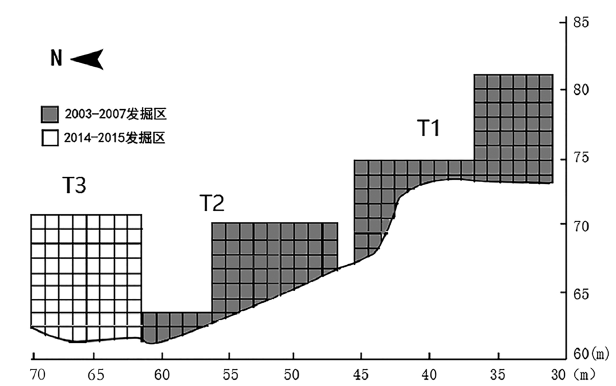

收稿日期: 2017-02-21
网络出版日期: 2020-07-17
基金资助
国家自然科学基金(41572022);中国科学院A类战略性先导科技专项“泛第三极环境变化与绿色丝绸之路建设”(XDA2004010102);中国科学院战略性先导科技专项资助(XDA05130301);国家自然科学基金(J0930007);国家重点基础研究发展计划(2015CB953803)
A preliminary analysis of the stone artifacts from the 2014~2015 excavation of Shuidonggou Locality 2, Ningxia Autonomous Region
Received date: 2017-02-21
Online published: 2020-07-17
水洞沟遗址第2地点2014-2015年的发掘集中于2003-2007发掘区北侧的T3区域,面积约80m 2。对应2003-2007发掘的层位划分,本次发掘共揭露6个文化层 (Culture Layer/CL),各层位都有发现文化遗物,其中2003-2007发掘揭露的CL4在T3发掘区缺失。本文对2014-2015年系统发掘的T3区6个层位中出土的2723件石制品进行研究。此次初步分析显示,CL1-CL5是T3发掘区的主要石制品出土层位,又以CL3遗存最为密集。硅质白云岩和燧石是主要的原料,其中硅质白云岩在各层中比例均接近半数。石器技术以锤击法为主,砸击法比例在后期有所增加。遗址整体文化面貌表现为典型的中国北方简单石片技术传统并有着较低的石核利用率,但在CL2和CL3石核利用率稍有提升,其石片产品总体以宽型石片为主。二次修理工具比例较低,并且以边刃刮削器为主,但也有比较有特色的楔形器发现出土。与2003-2007年T1-T2发掘区出土石制品进行简单对比发现,原料利用和石制品的层位组成都存在一定差异,这很可能是因为分析标准和发掘位置的差异所致。

张佩琪 , 张晓凌 , SamLIN , 郭家龙 , 王惠民 , NicolasZWYNS , 彭菲 , 高星 . 水洞沟第2地点2014-2015年出土石制品初步研究[J]. 人类学学报, 2020 , 39(01) : 30 -41 . DOI: 10.16359/j.cnki.cn11-1963/q.2019.0031
The excavation of Shuidonggou Locality 2 in 2014~2015 was focused on uncovering an area (T3) north of the units (T1 & T2) excavated previously in 2003~2007. The area exposed in T3 was approximately 80 m 2 in surface area and about 8 m in depth. A total of six cultural layers (CLs) were identified from the stratigraphic sequence; all of the layers correspond to those in T1 and T2, except for CL4 which is present in the previously excavated units but absent in T3. This paper reports on the analysis of 2723 lithic artifacts unearthed from the renewed excavation at T3. By analyzing the lithic raw material and the technology/typology of the stone artifacts among the cultural layers, we characterize diachronic shifts in lithic production strategy at SDG2. Results of this study provide additional evidence for understanding the behavior and adaptation of past human groups at Shuidonggou Locality 2.

| [1] | Boule M, Breuil H, Licent E , et al. Le Paléolithique de la Chine[M]. No.4, Ach. Inst. Paleont. Hum. Paris, 1928 |
| [2] | 汪宇平 . 水洞沟村的旧石器文化遗址[J]. 考古, 1962,11:588-589 |
| [3] | 贾兰坡, 盖培, 李炎贤 . 水洞沟旧石器时代遗址的新材料[J]. 古脊椎动物与古人类, 1964,8:75-83 |
| [4] | 宁夏文物考古研究所. 水洞沟——1980年发掘报告[M]. 北京: 科学出版社, 2003 |
| [5] | 高星, 王惠民, 裴树文 , 等. 水洞沟2003-2007年度考古发掘和研究报告[M]. 北京: 科学出版, 2013 |
| [6] | Brantingham PJ, Krivoshapkin A, Tserendagva Y . The initial Upper Paleolithic in Northeast Asia[J]. Current Anthropology, 2001,42(5):735-747 |
| [7] | 高星, 李进增, Madsen DB , 等. 水洞沟的新年代测定及相关问题讨论[J]. 人类学学报, 2002,21(3):211-218 |
| [8] | 李锋 . “文化传播”与“生态适应”——水洞沟遗址第2地点考古学观察[D]. 中国科学院大学博士学位论文, 2012: 107-129 |
| [9] | 彭菲 . 中国北方旧石器时代石叶遗存研究—以水洞沟与新疆材料为例[D]. 中国科学院大学博士学位论文, 2012: 73-94, 161-168 |
| [10] | 仪明洁 . 旧石器时代晚期末段中国北方狩猎采集者的适应策略——以水洞沟第12地点为例[D]. 中国科学院大学博士学位论文, 2013 |
| [11] | 关莹 . 水洞沟旧石器时代晚期遗址——古人类植物资源利用的个案研究[D]. 中国科学院大学博士学位论文, 2011 |
| [12] | 周振宇 . 水洞沟遗址石制品热处理实验研究[M]. 中国科学院大学博士学位论文, 2011 |
| [13] | 刘德成, 王旭龙, 高星 , 等. 水洞沟遗址地层划分与年代测定新进展[J]. 科学通报, 2009,54(33):2879-2885 |
| [14] | 刘德成, 高星, 王旭龙 , 等. 宁夏银川水洞沟遗址2号点晚更新世晚期孢粉记录的古环境[J]. 古地理学报, 2011,13(4):467-472 |
| [15] | Pei SW, Gao X, Wang HM , et al. The Shuidonggou site complex: new excavations and implications for the earliest Late Paleolithic in North China. Journal of Archaeological Science, 2012,39(12):3610-362 |
| [16] | 高星, 王惠民, 关莹 . 水洞沟旧石器考古研究的新进展与新认识[J]. 人类学学报, 2013,32(2):121-132 |
| [17] | Li F, Gao X, Chen FY , et al. New sights at the Shuidonggou site: a preliminary report at Shuidonggou Locality 2 in Northwest China[J]. Antiquity, 2013a,8:368-383 |
| [18] | Keates S, Kuzmin Y . Shuidonggou localities 1 and 2 in northern China: archaeology and chronology of the Initial Upper Palaeolithic in north-east Asia[J]. Antiquity, 2015,89(345):714-720 |
| [19] | Li F, Kuhn SL, Gao X . A response to Keates and Kuzmin[J]. Antiquity, 2015,89(345):721-723 |
| [20] | 陈福友, 李锋, 王惠民 , 等. 宁夏水洞沟遗址第2地点发掘报告[J]. 人类学学报, 2012,31(4):317-334 |
| [21] | Schick KD. Experimentally-derived criteria for assessing hydrologic disturbance of archaeological sites[A]. In: Nash D, Petraglia MD. Natural Formation Processes and the Archaeological Record[M]. 1987,352:86-107 |
| [22] | Dibble H, Schurmans U, Iovita R , et al. The Measurement and Interpretation of Cortex in Lithic Assemblages[J]. American Antiquity, 2005,70(3):545-560 |
| [23] | 张森水 . 中国旧石器文化[M]. 天津: 天津科学技术出版社, 1987 |
| [24] | 张森水, 宋惕冰 . 北京志·世界文化遗产卷·周口店遗址志[M]. 北京: 北京出版社, 2004 |
| [25] | Hayden B . Confusion in the bipolar world: Bashed pebbles and splintered pieces[J]. Lithic Technology, 1980,9(1):2-7 |
| [26] | Shott MJ . On bipolar reduction and splintered pieces[J]. North American archaeologist, 1999,20(3):217-238 |
| [27] | Li F, Kuhn SL, Gao X . Re-examination of the dates of large blade technology in China: A comparison of Shuidonggou Locality 1 and Locality 2[J]. Journal of Human evolution, 2013,64:161-168 |
/
| 〈 |
|
〉 |